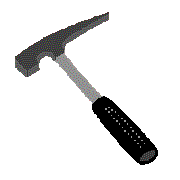"TOOLS & EQUIPMENT FOR FIELD TRIPS"
by
Drexel Pitts

As any mechanic or carpenter can tell you, the right tools make the job so much easier. The same holds true for the tools and equipment available for your use on field trips.
Personally, I am a field trip waiting to happen and this is the first of a series of my personal tricks of the trade. The first thing to remember when packing is that you must carry everything you pack into the site, tote it around as long as you're there and carry it back out along with everything you collected. So the less weight you have to haul the better. Conversely, needing something and not having it makes for a frustrating trip. So balancing your needs versus the might is the goal. What to pack depends on the trip and location. I always pack differently for a fossil trip compared to a rock trip but some things go along every time.
One of those tools is my version of a rock hammer. Instead of the classic pick like hammer, I use a masons hammer. The head has a large squared end on the front and the back is a gently curved horizontal "chisel". Mine is made by Vaughn and carried at Home Depot. It comes in 24 and 16 ounce models. I like it because of the size, light and design. It's small enough and light enough to carry in your hand, on your belt or in your pack.
Yet it's heavy enough to do fairly hard hammering. With a heavy head, the hammer does most of the work as opposed to your arm. The 24 oz is best for this, but smaller adults and kids might find it too tiring so the 16 oz will do. With a small chisel or the proper screwdriver and you can do a medium to delicate chiseling on a rock trip. You usually don't need a hammer on a fossil trip. But if you do find a fossil lodged in matrix, or need to split open that rock or clod of dirt this hammer stored out of the way in your backpack will do the job.
Finally the chisel end can be used as just that in conjunction with a sledge. It also makes a good hoe/ scrapper to remove dirt from around a rock or searching through the dirt looking for fossils. I use mine in the garden as well. It'll dig up weeds in a hurry.
All of this adds up to a superb multipurpose tool in for a little more than $20. If I could only take one tool, this would be it.
Sledge Hammers:
I am a picker-upper kind of collector. I hate to hammer. But when that specimen is too big to carry or even move or when there's one small beauty on a big ugly rock, you have no choice. When it comes to busting rocks, nothing beats a sledge hammer. At sites like Graves Mountain much of the collected material has been sledged. Either you do it yourself or pick up someone's leavings. Sledge hammers come in 3 sizes, full size (8 lb. or more), medium (4 lb.) and small (3 lb.).
Full size hammers have long straight handles about the size of a large ax handle. This hammer is intended only for the largest and hardest jobs. Only real go-getters and large adults should consider them. Usually they are applied directly to the rock itself without using chisels. With a chisel, it's a two person job and requires extreme caution for safety's sake. It's heavy to tote around all day. If you have a hand truck, a tip would be to stand it up there and tap/tie the handle to the side.
Both medium and small sledges are more convenient. Most fit well in your backpack, shoulder bag or on a tool belt. Both can be used with or without chisels. Small sledges are usually 3 lbs and have handles around 8'' long. Because of the comparatively light head and short handle this hammer is the easiest to handle and thus is the choice for smaller adults and kids. As I've said before, the heavier the head the more work the hammer does and the less work required of your arm. So I prefer the medium 4 lb. hammer. The handle is usually about 18" or so and this doesn't quite give me the precision control I want, so I just choke up about halfway on the handle. In effect I'm using a small hammer with a heavier head. But when you need the extra momentum, grab the handle at the bottom and flail away.
Sledge hammers of all sizes can be found at Wal-Mart, Home Depot, Loews and hardware stores. Prices are probably somewhere between $10 and $30, depending on the size and store. Handles are mostly wood, with fiberglass costing more. If the handle breaks, it's easier, safer and only a little more expensive to buy a new hammer. The factory probably does a lot better job than you on joining the two together.
Some rocks can't be broken without ruining the specimens. Some rocks can't be broken at all. But a sledge hammer will greatly increase your odds of having a successful trip and bringing more prized specimens home.
CHISELS:
We've discussed hammers, so it's time to turn our attention to their partners the chisels. There are 3 basic types of chisels: screwdrivers, cold chisels and what I'll call chisels with handles.
I have to start the screwdrivers with a safety warning. This isn't their intended use and there is a great variance in the quality of screwdrivers. Handles and shafts are subject to bending, breaking and even shattering, so use extreme caution. Never hit a screwdriver hard. With that said, the correct screwdriver can make a fine tool when used properly and is the best for light precision work. Look for a largish flat head with a solid looking handle. Avoid the translucent plastic handles. The one I carry is the large Popular Mechanics sold by Wal-Mart. It goes in my backup with my masons hammer on rock and fossil trips. Unfortunately they don't sell it separately anymore, now it comes in a two pack with a large Phillips.
Until recently cold chisels were all we had. They vary in diameter from about a quarter inch to around an inch and a half and will be about 6" to 8" long. They are slightly flared on the hammer end. They've been used by masons and mechanics forever. They can be found in most stores with a hardware department. They work well and as they get dull, they can be resharpened, however I'd recommend you steer clear of these and choose a chisel with a handle instead.
These chisels were first introduced as an alternative to the cold chisel, mostly for masonry purposes. The metal was a more modern type steel and as a result the chisels were thinner for the head size. The heads are of various shapes including flat, oversized flat and pointed. Except for the oversized flat heads, the chisels were usually longer at 8" to 12". Somewhere along the way someone had the brilliant idea of equipping them with a handle. The handle is made of a hard but flexible plastic. There is a grip for holding and a flared guard on top to protect the hand. A small amount of the chisel extends past the guard. If you're careful, you can flail away with your small sledge hammer and not smash your hand. If you're not careful, the hammer will glance off the guard and hit who knows what. The grip gives you better control of the chisel and helps protect against the vibration cause by the blow. The long chisel is useful as the more of the chisel you put into a rock, the more of a splitting wedge effect you get. If you just get one, I'd suggest a medium size with a medium flat head. If you get two, add a pointed version. They seem to be making some smaller ones these days, so they're approaching the usefulness of a screwdriver for precision work. Handle chisels can be found most anywhere they have a hardware section.
BACKPACKS:
The most essential piece of equipment for any field trip is the backpack and that's because its the best way to carry other stuff. There's certain things I carry on all trips; drink, food, first aid kit, poncho, towel, extra hat, masons hammer and screwdriver. These fit into my pack with room for optional items like camera, plastic bags, more drink etc. There's even room left over for a few specimens. With all this junk safely stowed in my backpack, my hands are free for picking up specimens, helping me clamber around the landscape and pulling my hand truck if I brought it. With the straps adjusted correctly and the pack riding high on my back, I'm not encumbered in any way and soon forget that its there. When I reach an area that I'm going to linger in, I'll set the pack in the shade as a base camp.
There are certain features you should look for. It should have a carrying handle on the top. If possible the bottom should be reinforced. The packs' straps should be adjustable, sturdy and have good connections to the pack on both ends. There should be 2 compartments in the main body of the pack so that you can segregate your supplies and specimens. These compartments should be zippered with a double zipper slide. This lets you open the compartment from the top and not the sides so stuff doesn't fall out. There should be smaller extra compartments or pockets on the front and sides. These are perfect for your wallet, cell phone, beepers etc. Of course the whole thing needs to be waterproof.
You can find backpacks year round at Kmart, Wal-Mart and sporting goods stores. These however tend to be expensive, maybe $30 or more. Your best deals price-wise and selection-wise are the book bags sold in the late summer and fall; these usually go for well under $20.
For the hard core field collectors there are times when you might want to haul out some giant rock and be unable/unwilling to take a handtruck. Toting it on your shoulder isn't the smart way to go. For these occasions, I suggest a medium to large ALICE pack. These are military packs that can be bought new or surplus. They have internal frames, backrests and belt straps making them perfect for large heavy loads. When I think I might need it, I'll carry it empty in the trunk. They are also great for general camping trips.

Copyright © Georgia Mineral Society, Inc.
